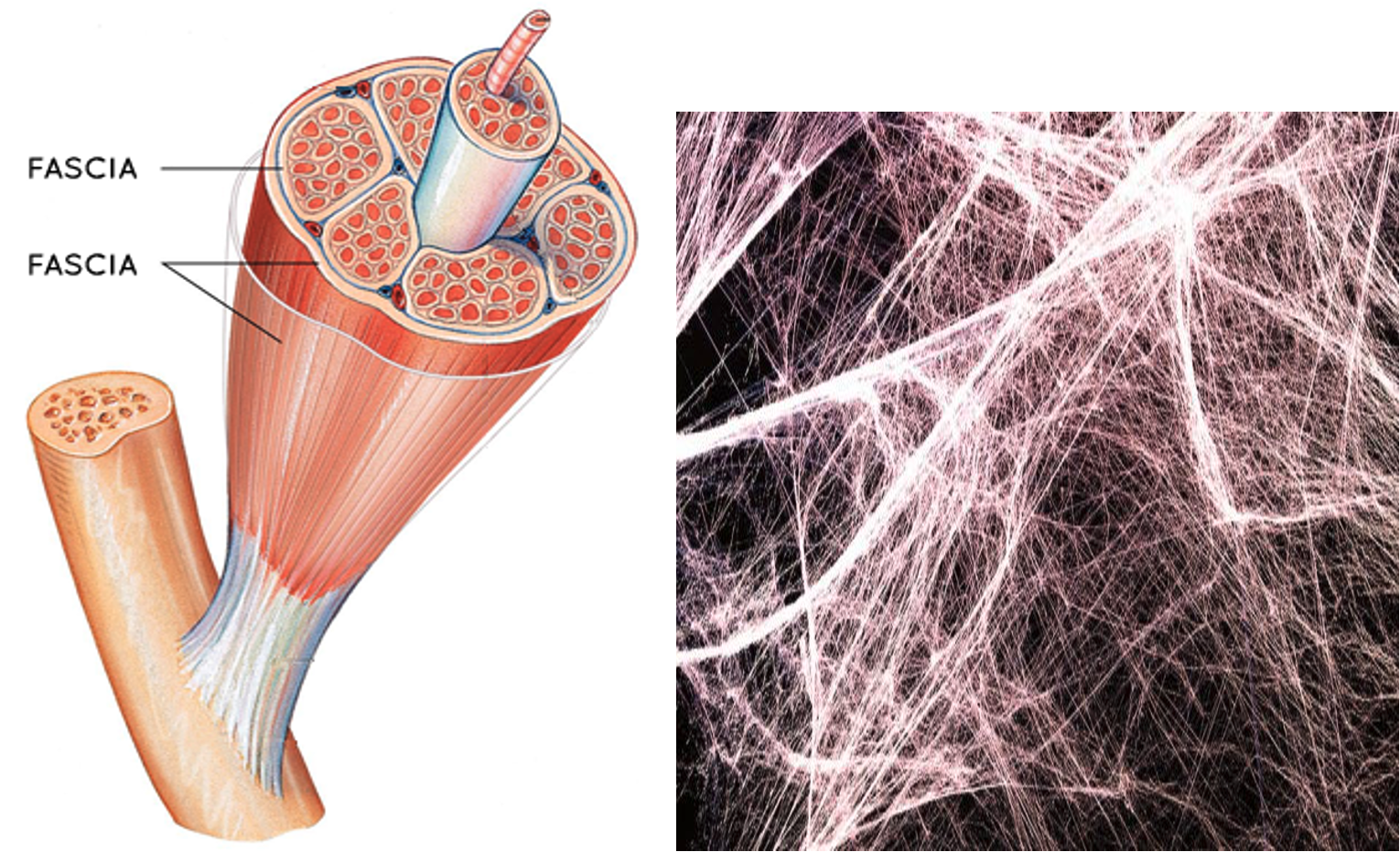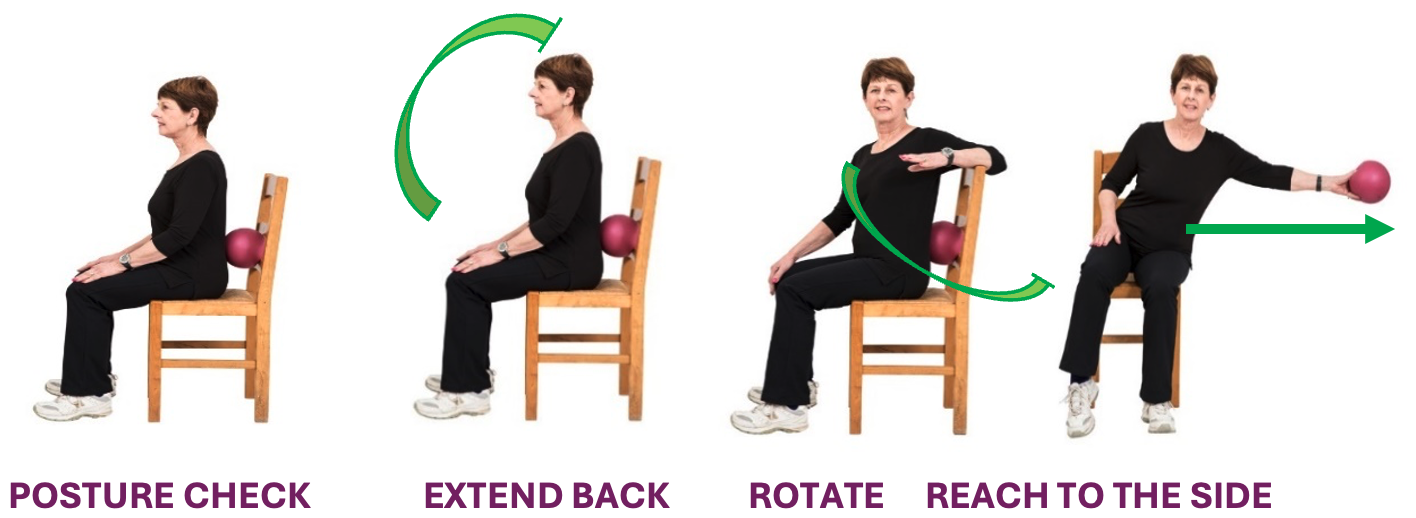Fascia, the all over body network
The following information comes partly from part of a larger article. It describes clearly and succinctly the complexity concerning the role that fascia plays to enable good movement to occur (some slight adaptations have been made where it fits in context with our health issues and level of abilities).
The Fascia-Mobility Connection
Mobility—the ability to move freely and easily—is heavily influenced by the condition of the fascia. Fascia can adapt to the stresses placed upon it, becoming either more elastic and flexible or tighter and more restrictive. Poor movement patterns, prolonged sitting, dehydration, and injury can lead to adhesions or tightness in the fascia, limiting range of motion and causing discomfort.

What is Fascia?
Fascia is a thin sheath of fibrous tissue enclosing muscles or other organs. It is a thin layer of connective tissue made primarily of collagen, and it serves several vital roles in the body. An easy way to visualize how fascia works in our bodies is to think of it as an intricate web. As a web, our fascial system is uninterrupted and runs from head to toe. This dense tissue covers every muscle, bone, nerve, as well as all other soft tissues in the body which includes all our organs and even arteries and veins. Our fascia is essentially responsible for holding our bodies together. This web-like structure surrounds and separates muscles, providing support and structure to the body while also enabling effective and easy movement. Fascia connects different muscle groups and integrates the body into a cohesive unit. Without fascia, our movements would lack the efficiency and coordination necessary for daily tasks
Fascia is a soft tissue and functions to provide our body with a stable scaffolding but at the same time allows movement, flexibility and tissue adaptation to occur such as building bigger muscles, putting on weight or allowing your stomach and surrounding structures to make room for the food you eat. Fascia can tighten however and form adhesions acting like a buildup of scar tissue in our muscles or ligaments.
Fascia comes in different forms to serve different purposes throughout the body, but the basic ingredients include collagen and ground substance. Collagen gives our fascia its structural mechanical properties and consists of closely packed bundles of wavy fibres that pull straight when under tension. Ground substance is a “gel like” substance a similar consistency to egg white. It fills in the gaps between the collagen and provides support, lubrication, moisture, nutrients and other important materials to our fascia.
Healthy fascia allows muscles to glide smoothly against each other, enabling full joint mobility. When fascia becomes stiff or adhered however, it restricts movement, leading to decreased flexibility and a higher likelihood of strain or injury.
Movement
Fascia thrives on movement. Regular physical activity helps keep the fascia hydrated and pliable by stimulating the production of hyaluronic acid, a substance that promotes tissue glide. Incorporating a variety of movements—stretching, strength training, and dynamic exercises—ensures that the fascia adapts to a range of demands.
When functioning optimally, our fascia will move, slide and glide with everything we do. When fascia is in a continually shortened position for prolonged periods from sedentary lifestyle and poor posture, it will adapt – shortening and tightening. Fascial restrictions can also occur from trauma, infection, inflammation or surgery as these ‘assaults’ impact the freedom of movement of our fascia, resulting in tension points, pain and compensation of surrounding tissues.
Hydration
Our body is made up of 60-65% water, and the reason the water doesn’t end up as a puddle on the ground is because our fascia organises the water and other body tissues into a structured network. Fascia contains a significant amount of water, which contributes to its elasticity and ability to glide smoothly. Dehydration can cause fascia to become stiff and prone to adhesions.
Summary
Fascia is an essential but often overlooked component of the body’s movement system. Its health and functionality significantly influence mobility, flexibility, and overall performance. By staying hydrated and maintaining regular movement, individuals can improve their fascial health and unlock their full potential.
As research into fascia continues to grow, its significance in mobility and performance becomes even clearer. Throughout the health and fitness industry it is beginning to be recognized that caring for fascia is as important as strengthening muscles or improving cardiovascular fitness.
Ways to help maintain good fascial properties and movement.
Here is are a few simple techniques that may help you to support fascial health:
Hydrate: This helps keep tissue lubricated and pliable.
- Drink plenty of water throughout the day
- Consume water-rich foods like fruits and vegetables
- Avoid excessive consumption of dehydrating substances like caffeine and alcohol.
Posture:
- Maintain optimal posture to allow your spine to maintain a neutral position and prevent buildup of fascial tightness. Slouching or excessively upright posture can result in fascial overload or tightness.
- Using a soft gym ball is a great piece of equipment which can assist stretch the lower back where there is a complex network of fascial fibres which benefit from stretching. (also to assist postural alignment)
Balls and backs – chair – ball centred in the region of small of back

Stretch
- Before you get out of bed in the morning try stretching your body gently in all directions focusing on rotational movements as they tend to become stiffer e.g. rolling from side to side
- Dynamic stretching and mobility exercises, such as yoga or Pilates, are particularly beneficial for fascia. These practices combine movement with flexibility, helping to keep the fascia supple and functioning wel
Warm up well before undertaking more vigorous exercise:
- Do some range of motion or dynamic stretching
Move frequently:
- Don’t sit in one place too long as this can cause fascia and muscles to get stuck in one position.
Nb Use a foam roller: If haven’t used one of these before, an allied health professional; o rexercise physiologist or fitness professional can help you to learn how to use it correctly.
Major information content written by Steve Irwin who is currently an Educator for the Australian Institute of Fitness and other appropriate sources.

Comments are closed.